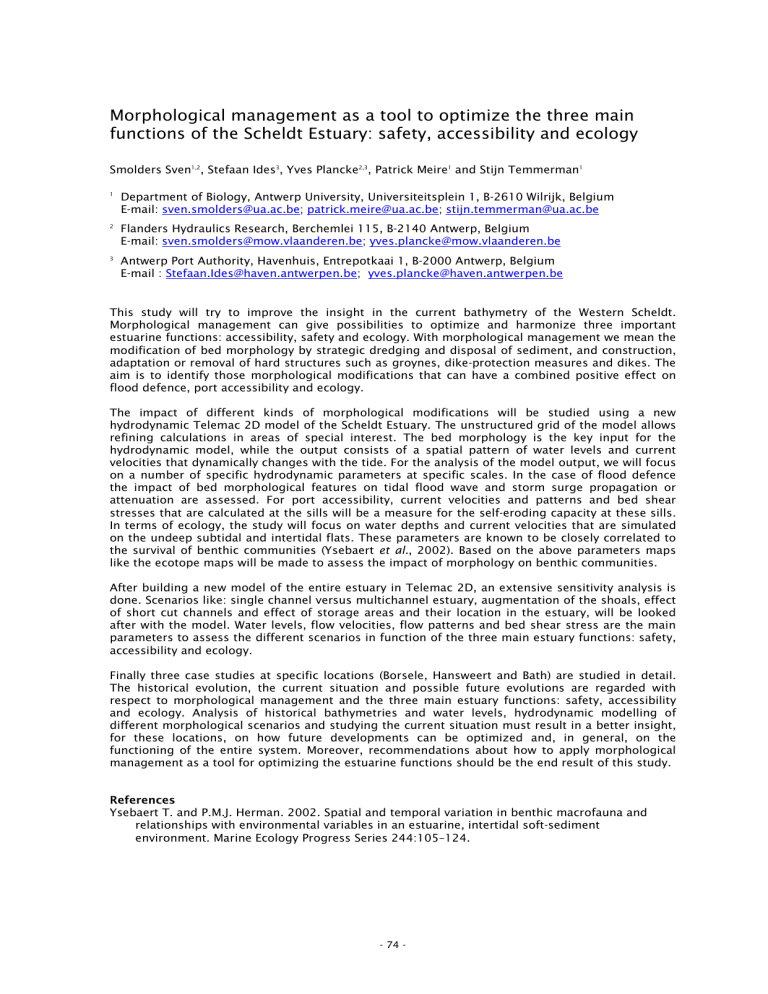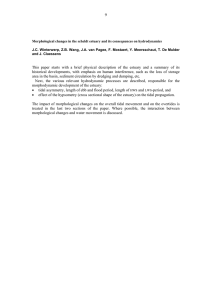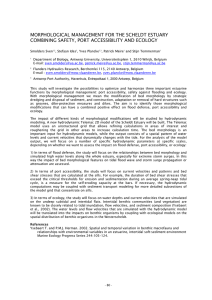Morphological management as a tool to optimize the three main

Morphological management as a tool to optimize the three main functions of the Scheldt Estuary: safety, accessibility and ecology
Smolders Sven 1,2 , Stefaan Ides 3 , Yves Plancke 2,3 , Patrick Meire 1 and Stijn Temmerman 1
1 Department of Biology, Antwerp University, Universiteitsplein 1, B-2610 Wilrijk, Belgium
E-mail: sven.smolders@ua.ac.be
; patrick.meire@ua.ac.be
; stijn.temmerman@ua.ac.be
2 Flanders Hydraulics Research, Berchemlei 115, B-2140 Antwerp, Belgium
E-mail: sven.smolders@mow.vlaanderen.be
; yves.plancke@mow.vlaanderen.be
3 Antwerp Port Authority, Havenhuis, Entrepotkaai 1, B-2000 Antwerp, Belgium
E-mail : Stefaan.Ides@haven.antwerpen.be
; yves.plancke@haven.antwerpen.be
This study will try to improve the insight in the current bathymetry of the Western Scheldt.
Morphological management can give possibilities to optimize and harmonize three important estuarine functions: accessibility, safety and ecology. With morphological management we mean the modification of bed morphology by strategic dredging and disposal of sediment, and construction, adaptation or removal of hard structures such as groynes, dike-protection measures and dikes. The aim is to identify those morphological modifications that can have a combined positive effect on flood defence, port accessibility and ecology.
The impact of different kinds of morphological modifications will be studied using a new hydrodynamic Telemac 2D model of the Scheldt Estuary. The unstructured grid of the model allows refining calculations in areas of special interest. The bed morphology is the key input for the hydrodynamic model, while the output consists of a spatial pattern of water levels and current velocities that dynamically changes with the tide. For the analysis of the model output, we will focus on a number of specific hydrodynamic parameters at specific scales. In the case of flood defence the impact of bed morphological features on tidal flood wave and storm surge propagation or attenuation are assessed. For port accessibility, current velocities and patterns and bed shear stresses that are calculated at the sills will be a measure for the self-eroding capacity at these sills.
In terms of ecology, the study will focus on water depths and current velocities that are simulated on the undeep subtidal and intertidal flats. These parameters are known to be closely correlated to the survival of benthic communities (Ysebaert et al.
, 2002). Based on the above parameters maps like the ecotope maps will be made to assess the impact of morphology on benthic communities.
After building a new model of the entire estuary in Telemac 2D, an extensive sensitivity analysis is done. Scenarios like: single channel versus multichannel estuary, augmentation of the shoals, effect of short cut channels and effect of storage areas and their location in the estuary, will be looked after with the model. Water levels, flow velocities, flow patterns and bed shear stress are the main parameters to assess the different scenarios in function of the three main estuary functions: safety, accessibility and ecology.
Finally three case studies at specific locations (Borsele, Hansweert and Bath) are studied in detail.
The historical evolution, the current situation and possible future evolutions are regarded with respect to morphological management and the three main estuary functions: safety, accessibility and ecology. Analysis of historical bathymetries and water levels, hydrodynamic modelling of different morphological scenarios and studying the current situation must result in a better insight, for these locations, on how future developments can be optimized and, in general, on the functioning of the entire system. Moreover, recommendations about how to apply morphological management as a tool for optimizing the estuarine functions should be the end result of this study.
References
Ysebaert T. and P.M.J. Herman. 2002. Spatial and temporal variation in benthic macrofauna and relationships with environmental variables in an estuarine, intertidal soft-sediment environment. Marine Ecology Progress Series 244:105–124.
- 74 -






